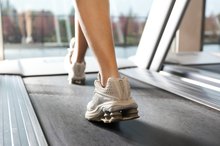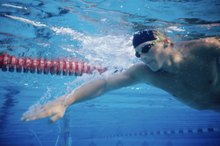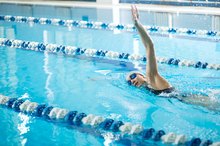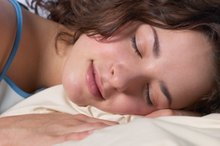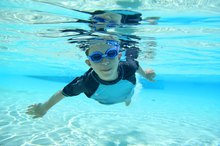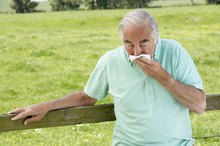Why Is Swimming Good for Asthma?
Regular exercise offers many benefits for people with asthma, including less frequent asthma symptoms, and improved heart and physical fitness. Swimming is a healthy form of aerobic exercise for people with asthma, especially for those whose symptoms are triggered by outdoor allergies or cold temperatures. The advantages of water-based exercise for people with asthma include breathing warm, humid air that often lacks or contains reduced levels of allergy-triggering substances found outdoors. Some research suggests that swimming regularly may improve lung function in people with asthma.
Lung-Friendly Air
The air you breathe while swimming -- particularly indoors -- is lung-friendly. Warm, moist air doesn't irritate the lungs the way cold, dry air often does. Breathing humid air also cuts down on airway drying caused by an increased breathing rate during exercise. Airway drying can trigger asthma symptoms. Additionally, indoor pools don't expose you to outdoor allergens, such as pollen and mold spores. These substances are common symptom triggers for people with allergic asthma, which can make outdoor physical activity difficult.
- The air you breathe while swimming -- particularly indoors -- is lung-friendly.
- These substances are common symptom triggers for people with allergic asthma, which can make outdoor physical activity difficult.
Cardiovascular Fitness
What Causes Burning in the Chest When Walking on the Treadmill?
Learn More
Swimming is good way to improve cardiovascular fitness for people with asthma. An April 2013 "Cochrane Database of Systematic Reviews" article investigated the effect of swimming training on subjects younger than 19 with stable asthma. The authors concluded that swimming improves lung function, and heart and lung fitness. There was no evidence that swimming had negative effects on asthma control or flareups. However, the study could not address how swimming compares to other aerobic activities.
- Swimming is good way to improve cardiovascular fitness for people with asthma.
- However, the study could not address how swimming compares to other aerobic activities.
Lung Function Improvement
A July 2007 study in the "Scientific World Journal" examined effects of an indoor swimming and asthma education program in 65 adults with mild, persistent asthma on inhaled medications. After six months, the swimmers had improved lung function and decreased airway reactivity, compared to those who did not participate. A July 2014 "Cochrane Database of Systematic Reviews" article examined the medical research on the effects of water-based exercise on adults with asthma. While the authors found no evidence of potential harm, they were not able to draw any conclusions about potential benefits, because of the limited studies to date. More research is needed to determine the specific effects of swimming on adults with asthma.
- A July 2007 study in the "Scientific World Journal" examined effects of an indoor swimming and asthma education program in 65 adults with mild, persistent asthma on inhaled medications.
Chlorine and Asthma
Swimming and Sore Throats
Learn More
Chlorine, a chemical used to sanitize pool water, is often irritating to people with asthma and may cause difficulty breathing. When chlorine escapes from the water, it is diluted in the air and moved away from the water surface by circulating air. If you swim in an indoor chlorinated pool, a well-ventilated facility with high ceilings and ample space around the deck area can help reduce chlorine concentration in the air. Avoiding places with recirculating air, low ceilings or high pool sides may help prevent asthma flareups due to chlorine inhalation. Chlorine-free or saltwater pools, and outdoor swimming may be good alternatives if chlorine triggers your asthma symptoms.
- Chlorine, a chemical used to sanitize pool water, is often irritating to people with asthma and may cause difficulty breathing.
- Avoiding places with recirculating air, low ceilings or high pool sides may help prevent asthma flareups due to chlorine inhalation.
Safety Precautions
A faster breathing rate during exercise may trigger asthma symptoms in some people. Be proactive and take asthma medications as directed to help prevent exercise-induced asthma symptoms. Keeping a quick-relief inhaler poolside is also advisable, in case you experience symptoms while swimming.
Swimming is not a treatment for asthma, and medications should always be used as prescribed. Talk to your doctor before starting a new physical activity.
Medical advisor: Shilpi Agarwal, M.D.
- A faster breathing rate during exercise may trigger asthma symptoms in some people.
- Keeping a quick-relief inhaler poolside is also advisable, in case you experience symptoms while swimming.
Related Articles
References
- Sports Health: Exercise-Induced Bronchospasm
- Asthma and Allergy Foundation of America: Allergic Asthma
- The Scientific World Journal: Swimming and Persons with Mild Persistant Asthma
- San Diego State University: "Swimmer's Asthma": The Serious Health Problem with Chlorinated Pools
- European Respiratory Journal: Swimming Pool Attendance and Risk of Asthma and Allergic Symptoms in Children
- Informed Health Online: Asthma: What Effect Do Sports and Exercise Have?
- Asthma and Allergy Foundation of America. Asthma facts and figures. Updated June 2019.
- Asthma and Allergy Foundation of America. Allergic asthma. Updated September 2015.
- American College of Allergy, Asthma, and Immunology. Nonallergic asthma.
- Leynaert B, Sunyer J, Garcia-Esteban R, et al. Gender differences in prevalence, diagnosis and incidence of allergic and non-allergic asthma: a population-based cohort. Thorax. 2012;67(7):625–631. doi:10.1136/thoraxjnl-2011-201249
- Côté A, Turmel J, Boulet LP. Exercise and asthma. Semin Respir Crit Care Med. 2018;39(1):19-28. doi:10.1055/s-0037-1606215
- Vandenplas O, Suojalehto H, Cullinan P. Diagnosing occupational asthma. Clin Exp Allergy. 2017;47(1):6-18. doi:10.1111/cea.12858
- Niimi A. Cough and asthma. Curr Respir Med Rev. 2011;7(1):47–54. doi:10.2174/157339811794109327
- Lo PC, Tsai YT, Lin SK, Lai JN. Risk of asthma exacerbation associated with nonsteroidal anti-inflammatory drugs in childhood asthma: A nationwide population-based cohort study in Taiwan. Medicine (Baltimore). 2016;95(41):e5109. doi:10.1097/MD.0000000000005109
- Sutherland ER. Nocturnal asthma. J Allergy Clin Immunol. 2005;116(6):1179–1187. doi:10.1016/j.jaci.2005.09.028
- Wadhwa R, Dua K, Adcock IM, Horvat JC, Kim RY, Hansbro PM. Cellular mechanisms underlying steroid-resistant asthma. Eur Respir Rev. 2019;28(153) doi:10.1183/16000617.0096-2019
- Zhang Y, Leung DY, Goleva E. Anti-inflammatory and corticosteroid-enhancing actions of vitamin D in monocytes of patients with steroid-resistant and those with steroid-sensitive asthma. J Allergy Clin Immunol. 2014;133(6):1744-52.e1. doi:10.1016/j.jaci.2013.12.004
- Cleveland Clinic. Wheezing. Updated June 30, 2017.
- Mokoka MC, Ullah K, Curran DR, O'connor TM. Rare causes of persistent wheeze that mimic poorly controlled asthma. BMJ Case Rep. 2013;2013. doi:10.1136/bcr-2013-201100
- Bonini M, Polange P. Exercise-induced bronchoconstriction: new evidence in pathogenesis, diagnosis and treatment Asthma Research and Practice, 2015, 1:2.
- Dicpinigaitis PV. Chronic Cough Due to Asthma: ACCP Evidence-Based Clinical Practice Guidelines.
- O'Byrne, P. Patient Information. Exercise-Induced Asthma.
- Tan NC, Nadkarni NV, Lye WK, et al. Ten-year longitudinal study of factors influencing nocturnal asthma symptoms among Asian patients in primary care. NPJ Prim Care Respir Med. 2015; 25: 15064.
- American Lung Association. Severe Asthma. Updated 2020.
- American Academy of Allergy, Asthma & Immunology. Severe Asthma. Updated 2020.
- Asthma and Allergy Foundation of America. What Are the Symptoms of Asthma?. Updated 2015.
- College of Asthma, Allergies, and Immunology. Asthma attacks. Updated 2014.
- Yung JA, Fuseini H, Newcomb DC. Hormones, sex, and asthma. Ann Allergy Asthma Immunol. 2018;120(5):488-494. doi:10.1016%2Fj.anai.2018.01.016
- American Lung Association. The Link Between Asthma and Weight. Updated 2016.
- Polosa R, Thomson NC. Smoking and asthma: dangerous liaisons. Eur Respir J. 2013;41(3):716-726. doi:10.1183/09031936.00073312
- American Lung Association. The Health Effects of Smoking with Asthma. Updated 2020.
- Kong D-L, Qin Z, Shen H, Jin H-Y, Wang W, Wang Z-F. Association of obstructive sleep apnea with asthma: a meta-analysis. Sci Rep. 2017;7(1):4088. doi:10.1038%2Fs41598-017-04446-6
- American College of Allergy, Asthma & Immunology. Sinus Infection. Updated 2014.
- Egan M, Bunyavanich S. Allergic rhinitis: the "Ghost Diagnosis" in patients with asthma. Asthma Res Pract. 2015;1:8. doi:10.1186/s40733-015-0008-0
- Shah SGS. A Commentary on "Ensuring safe surgical care across resource settings via surgical outcomes data & quality improvement initiatives." Int J Surg. 2019;72:14-15. doi:10.3109/02770903.2012.662568
- Churg Strauss Syndrome. National Organization for Rare Disorders (NORD). Updated 2020.
- Lee SH, Ban GY, Kim SC, et al. Association between primary immunodeficiency and asthma exacerbation in adult asthmatics. Korean J Intern Med. 2020;35(2):449-456. doi:10.3904%2Fkjim.2018.413
- Gherasim A, Dao A, Bernstein JA. Confounders of severe asthma: diagnoses to consider when asthma symptoms persist despite optimal therapy. World Allergy Organ J. 2018;11(1):29.
- Barisione G, Baroffio M, Crimi E, Brusasco V. Beta-Adrenergic Agonists. Pharmaceuticals (Basel). 2010;3(4):1016-1044. doi:10.3390%2Fph3041016
- Shah R, Saltoun CA. Acute severe asthma (Status asthmaticus). Allergy asthma proc. 2012;33(3):47-50. doi:10.2500/aap.2012.33.3547
- Ding B, Small M. Disease burden of mild asthma: findings from a cross-sectional real-world survey. Adv Ther. 2017;34(5):1109-1127. doi:10.1007%2Fs12325-017-0520-0
Writer Bio
Natasha Freutel is a California-licensed Occupational Therapist. She specializes in orthopedic rehabilitation, and wellness during pregnancy, postpartum, or after injury. She is also the owner of Fit Mama Santa Barbara and works with women of all ages to help them look and feel great through exercise and nutrition.
